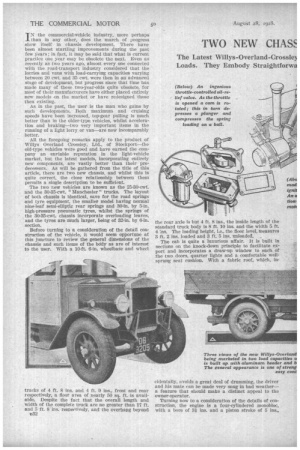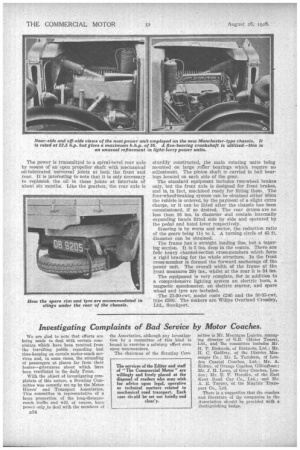TWO NEW CHASE OR LIGHT LOADS.
Page 16

Page 17

Page 18

If you've noticed an error in this article please click here to report it so we can fix it.
The Latest Willys-Overland-Crossle). Loads. They Embody Straightforwa cts are for 25-30-cwt. and 30-35-cwt. Robust Design at Moderate Prices.
TN the commercial-vehicle industry, more perhaps than in any other, does the march of progress show itself in chassis development. There have been ahnost startling improvements during the past few years; in fact, it May be said that what is current practice one year may be obsolete the next. Even as recently as two years ago, almost every one connected with the, road-transport industry considered that the lorries and vans with load-carrying capacities varying between 20 cwt. and 35 cwt. were then in an advanced stage of development, but progress since that time has made many of these two-year-olds quite obsolete, for most of their manufacturers have either placed entirely new models on the market or have redesigned those then existing.
As in the past, the user is the man who gains by such developments. Both maximum and cruising speeds have been increased, top-gear pulling is much better than in the older-type, vehicles, whilst acceleration and braking—two very important items in the running of a light lorry or van—are now incomparably better.
All the foregoing remarks apply to the product of Willys Overland Crossley, Ltd., of Stockport—the old-type vehicles were good and have earned the company an . enviable reputation in the light-vehicle market, but the latest models, incorporating entirely new components, are vastly better than their predecessors. As will be gathered from the title of this article, there are two new chassis. and whilst this is quite correct, the close relationship between" them permits a single description to be sufficient.
The two new vehicles are known as the 25-30-cwt. and the 30-35-cwt. 'Manchester" trucks. The layout of both chassis is identical, save for the road springs and tyre equipment, the smaller model having normal nine-leaf semi-elliptic rear springs and 30-in, by 5-in. high-pressure pneumatic tyres, whilst the springs of the 30-35-cwt. chassis incorporate overloading leaves, and the tyres are much larger, being of 32-in. by 6-in. section.
Before -turning to a consideration of the detail construction of the vehicle, it would seem opportune at this juncture to review the general dimensions of the chassis and such items of the body as are of interest to the user. With a 10-ft. 6-in, wheelbase and wheel
tracks of 4 ft. 8 ins. and 4 ft. 9 ins., front and rear respectively, a floor area of nearly 50 sq. ft. is available. Despite the fact that the overall length and width of the complete truck are no greater than 17 ft. and 5 ft. 8 ins. respectively, and the overhang beyond s32 the rear axle is but 4 ft. 8 ins., the inside length of the standard truck body is 8 it 10 ins, and the width 5 ft. 4'ins. The loading height, i.e., the floor level, measures 3 ft. 2 ins, loaded and 3 ft. 5 ins. unloaded. .
The cab is quite a luxurious affair. It is built in sections on the knock-down principle to facilitate export and incorporates a draw-up window to each of the two doors, quarter lights and a comfortable wellsprung seat cushion. With a fabric roof, which, in
cidentally, volds a great deal of drumming, the driver and his mate can be made very snug in bad weather— a feature that should make a distinct appeal to the owner-operator.
Turning now to a consideration of the details of construction, the engine is a four-cylindered monobloc, with a bore of 3i ins. and a piston stroke of 5 ins., giving a total capacity of 220.9 Cu. ins, and an R.A.C. rating of 22.5 h.p. The power characteristics of the engine are of more than passing interest, for a high maximum-power output has been combined with an excellent torque figure at low engine speeds. Actu ally, the maximum output of 4$ b.h.p. occurs at $6 m.p.h. in top gear, and the maximum torque at 16 m.p.h. on top gear. Thus, the engine should have a very useful all-round performance. The torque figure, by the way, is 130 ft.-lb. at a trifle over 1,000 r.p.m There is not a great number of light lorry engines that can boast five-bearing crankshafts, yet such an item finds a place in the specification of the new Overlands. The lubrication system, too, is planned on very good lines, all the major bearings of the engine being pressure-fed. A gear-type pump, submerged in the sump, draws lubricant therefrom '(through a filter) and forces it up to a longitudinal channel whence each oE the crankshaft and camshaft bearings is fed via internally drilled passages. The big-end bearings of the connecting rods obtain their supply by further passages drilled in the crankshaft webs.
An ingenious throttle-operated release valve is included in tile system, with the objects of reducing the consumption and preventing oiling-up of the sparking plugs. The valve itself is controlled by a cam which, when rotated Ey the throttle lever, depresses a plunger, thereby compressing the spring of a ball valve. Thus, as the throttle is opened, the pressure in the system is increased from the normal idling pressure of 15 Lb. per sq. in. to a maximum of 60 lb. per sq. in.
For the rest the engine follows quite straightforward practice. Side-by-side valves operated by mushroomheaded tappets are contained in an oiltight recess in the cylinder block, whilst communicating holes between the inside of the crankcase and the camshaft-tappet compartment enure efficient lubrication of all the parts. Distribution is effected entirely by gears, helical spur pinions being employed throughout. The generator is driven from the camshaft gear, a fabric wheel being utilized in the interests of silence.
One of the most interesting features in the perfcirm-. ance of this new Willys-Overland-Crossley product is the manner in which the engine will accelerate from dead slow speeds under load. This characteristic was demonstrated to us in no uncertain manner. Running along a slightly uphill grade at about 4 m.p.h. on top gear, the foot could be banged down on to the accelera tor pedal when, without any suspicion of hesitancy, the engine would steadily pick up speed smoothly and with no pinking. The carburetter is one factor which contributes very largely to this excellent characteristic.
The instrument employed is the Stromberg pump-type unit, in which a spring-loaded valve supplies a jet of neat petrol into the induction pipe immediately upon a violent opening of the throttle. This type 4 car buretter was described and illustrated in a resume of carburetter developments which we published a, few weeks ago.
Following modern practice, a single-plate clutch Is used ; this incorporates toggle levers in order to obtain a light pedal pressure. The gearbox' is mounted unit-wise with the engine, an extension of the casing forming a bell housing for the clutch. The gearbox itself is of a special heavy-duty type. The casing is of cast-iron and, being well braced, is extremely rigid. All shafts are of stiff section and comparatively short. The approximate ratios are 1st, 24.6 to 1 ; 2nd, 13 to 1; top, 6.12 to 1; and reverse, 30.2 to 1. The power is transmitted to a spiral-bevel rear axle by means ot an open propeller shaft with mechanical oil-lubricated universal joints at both' the front and rear. It is intefesting to note that it is only necessary to replenish the oil in these joints •at intervals of about six 'months. Like the gearbox, the rear axle is sturdily constructed, the main rotating units being mounted on large rofler bearings which require no adjustment. The pinion shaft is carried in ball bearings located on each side of the gear.
The standard equipment includes two-wheel brakes only, but the front axle is designed for front brakes, and is, in fact, machined ready for fitting them. The four-wheel-braking system can be obtained either when the vehicle is ordered, by the payment of a slight extra charge, or it can be fitted after the chassis has• been commissioned, if so desired. The rear drums are no less than 16 ins, in diameter and contain internally expanding bands fitted side by side and operated by the pedal and hand lever respectively.
Steering is by worm and sector, the reduction ratio of the gears being lfl to 1. A turning circle of 45 ft. diameter can be obtained.
The frame has a straight loading line, but a tapering section. It is 5 ins, deep in the centre. There are follr heavy channel-section cross-members which form a rigid bracing for the whole structure. In the front cross-member is formed the forward anchorage of the power unit. The overall width of the frame at the front measures 29iins., whilst at the rear it is 34 ins.
The equipment is very complete, for in addition to a comprehensive lighting system an electric horn, a magnetic speedometer, an electric starter, and spare wheel and tyre are included.
The 25-30-cwt. model costs £2415 and the 30-35-cwt. type £200. The makers are Willys Overland Crossley, Ltd., Stockport.
































